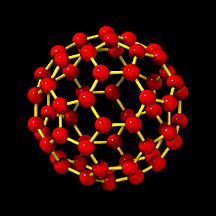 "Buckyballs," the subject of this poem, are large molecules made entirely of
carbon atoms arranged in a roughly spherical form. They are only
roughly spherical, though; their actual shapes are geodesic
domes, conceptualized in architecture by R. Buckminster Fuller, and
popularized in dome homes, soccer balls, and in Disney's Epcot Center main
gate. The nickname of these molecules, "buckyballs," is in honor of the
architect "Bucky" Fuller, as is the technical name "buckminsterfullerenes," or
just "fullerenes" for short. There are several sizes of buckyballs,
C60 (shown at right), C76, C78,
C84, and C102, to name a few, and since their discovery,
"buckytubes" and "buckytoruses" have also been synthesized.
"Buckyballs," the subject of this poem, are large molecules made entirely of
carbon atoms arranged in a roughly spherical form. They are only
roughly spherical, though; their actual shapes are geodesic
domes, conceptualized in architecture by R. Buckminster Fuller, and
popularized in dome homes, soccer balls, and in Disney's Epcot Center main
gate. The nickname of these molecules, "buckyballs," is in honor of the
architect "Bucky" Fuller, as is the technical name "buckminsterfullerenes," or
just "fullerenes" for short. There are several sizes of buckyballs,
C60 (shown at right), C76, C78,
C84, and C102, to name a few, and since their discovery,
"buckytubes" and "buckytoruses" have also been synthesized.
This poem was first published in the May 1997 issue of The New Zealand Science Monthly.
(back to "Scientific
Poetry" Table of Contents)
| No one on earth had ever seen, Or even dreamt it could have been, That carbon atoms, by themselves, Could form these tiny, hollow shells.
But that's exactly what they do,
(Now that is its informal name;
Now if you thought, you are correct:
But, getting back to chemistry,
Or think about a soccer ball:
And all these carbons seem to know
The biggest problem with these things |